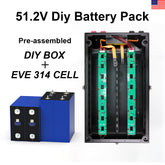Batteries Connected in Series or Parallel What Are the Key Differences
- Batteries in Parallel: Doubling Capacity for Extended Runtime
- Series vs Parallel: Which Configuration is Right for You?
- How Batteries in Series Work
In a series connection, the total voltage is the sum of the individual battery voltages, while the capacity remains the same as one single battery. For instance, connecting two 12V batteries in series gives you a total of 24V, but the capacity will still be the same as the individual battery, usually 100Ah. This configuration is often used in larger systems where higher voltage is needed but you don’t necessarily require more storage capacity.
- Common Applications for Series Battery Connections
Batteries connected in series are widely used in various applications. For example:
- Hedge Trimmer Battery Packs: In more powerful models, multiple smaller batteries may be connected in series to provide the higher voltage needed to run the motor efficiently.
- Solar Energy Storage: Solar systems with battery banks often use series connections to increase the voltage to match the inverter requirements.
- Electric Vehicles: Many electric vehicles use series connections to increase their overall system voltage, enabling higher motor power and driving range.
- Advantages and Disadvantages of Batteries in Series
- Advantages:
- Higher voltage output for demanding applications.
- Flexible design, allowing you to scale up voltage without sacrificing capacity.
- Disadvantages:
- If one battery in a series fails, the entire system can be compromised.
- Balancing the batteries can become tricky, as the charging and discharging cycles need to be carefully managed to avoid overcharging or discharging any single cell.
>>See also How To Power RV Air Conditioning With Solar Energy
Choosing the Right Voltage for Your Needs
When deciding whether to connect batteries in series, it’s essential to know the voltage requirements of your system. For example, a standard 12V solar system will typically consist of 12V batteries, but in larger systems, such as a hedge trimmer that requires more power, you may need to go with a 24V or 48V configuration.
- Consideration for Hedge Trimmers:
If you're powering a hedge trimmer with a larger battery pack, a series connection may be necessary to supply enough voltage to operate the trimmer’s motor efficiently.
Batteries in Parallel: Doubling Capacity for Extended Runtime
On the other hand, when you connect batteries in parallel, you connect the positive terminals together and the negative terminals together. In this configuration, the voltage remains the same as one battery, but the capacity (Ah) increases. For example, two 12V 100Ah batteries connected in parallel will maintain 12V, but the overall capacity will increase to 200Ah.
- How Batteries in Parallel Work
Connecting batteries in parallel is often used when you need to increase the battery bank's overall capacity without increasing the voltage. This configuration ensures that your system can store more energy, providing longer runtimes for devices or systems that need extended power but don't require higher voltage.
- Common Applications for Parallel Battery Connections
Batteries connected in parallel are typically found in systems where high capacity is needed but voltage doesn’t need to increase, such as:
- Off-Grid Solar Systems: When you need longer battery life without increasing voltage.
- Backup Power Systems: For homes or businesses requiring a reliable source of power during an outage, a parallel connection can provide the required storage without complicating the system’s voltage requirements.
- Electric Tools like Hedge Trimmers: If a longer runtime is needed without adjusting the power level, parallel connections can be useful.
- Advantages and Disadvantages of Batteries in Parallel
- Advantages:
- Increases the overall capacity (Ah), allowing for longer run times.
- Useful for applications where higher voltage is not necessary.
- Disadvantages:
- The voltage remains the same, so you can't increase the power output.
- Batteries need to be closely matched to avoid uneven charging or discharging.
electing Parallel Connections for Efficient Energy Storage
If your goal is to maximize the available energy storage for extended usage, a parallel configuration could be the right choice. For example, if you need to keep your hedge trimmer running longer during a job, a parallel connection of several batteries would allow you to work longer without having to stop and recharge.
Series vs Parallel: Which Configuration is Right for You?
Choosing between series and parallel connections depends on your specific needs. In some cases, a combination of both configurations may even be necessary to meet both voltage and capacity requirements.
- When to Use Series Connections
Use series connections when:
- You need higher voltage to power larger devices or systems.
- You're building a system that needs to match a specific inverter or motor voltage.
- When to Use Parallel Connections
Use parallel connections when:
- You need to increase the battery capacity for longer runtimes.
- You are working with devices that require a stable voltage but need more power over time.
- Combination of Series and Parallel
Sometimes, it is necessary to use both series and parallel connections. For example, in a large solar system, you might use series connections to achieve the required voltage and then connect those series strings in parallel to increase the total capacity.
>>See also What Is The Difference Between Group 31 And Group 34
Key Takeaways for Choosing Battery Configurations
The key to selecting the right configuration is understanding your system's needs. Whether you are powering a hedge trimmer or setting up a solar array, both series and parallel connections offer distinct benefits that can help you optimize your system's performance.
In conclusion, both series and parallel connections have their advantages and disadvantages. Understanding the specific needs of your system is essential to making the right choice. For applications requiring higher voltage, such as hedge trimmers and solar power systems, series connections are typically the best option. On the other hand, for systems that require extended runtime without increasing voltage, parallel connections are ideal.
Whichever configuration you choose, remember that balancing the batteries and ensuring proper maintenance are key to optimizing the performance and lifespan of your battery setup.
When choosing the right battery configuration for your needs, whether it’s powering a hedge trimmer or setting up a solar energy system, understanding the key differences between series and parallel connections is crucial. Both configurations offer distinct benefits depending on whether you need higher voltage or increased capacity. By making the right choice, you can optimize the efficiency and longevity of your battery-powered systems.
























Leave a comment
All blog comments are checked prior to publishing